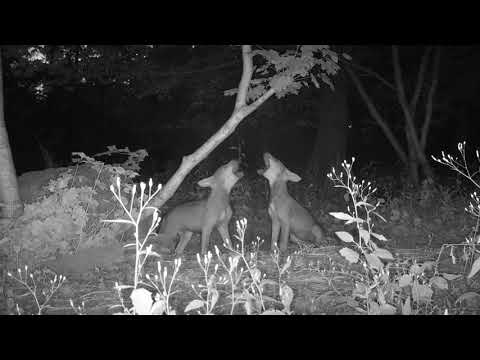- The uniqueness of red wolf (Canis rufus) howling behavior and its significance in social structure.
- Conservation efforts and why red wolf pups are critically endangered.
- The role of night cameras in wildlife monitoring and research specifically for red wolves.
- Insights from the [video_desc] and how it contributes to conservation strategies.
- Implications for future conservation and habitat management based on new findings.
The red wolf (Canis rufus) is an exceptionally rare canid, native to the southeastern United States, with unique vocalization behavior that plays a significant role in their social dynamics. Recent footage captured by a night camera highlights the howling behavior of red wolf pups in the wild, providing critical insights into their social structure. Howling serves not just as a communication method but also as a bonding exercise that strengthens pack cohesion.
The howling of red wolf pups, captured in the [video_desc], demonstrates their early involvement in pack activities. Normally observed among adult wolves, pup howling indicates the transmission of important social behavior from an early age. This behavior likely aids in developing the pups’ understanding of territory and social hierarchy. Vocalizations are essential for maintaining pack unity and delineating boundaries against intruders.
Red wolves are critically endangered, with fewer than 20 individuals left in the wild, primarily due to habitat loss, human-wildlife conflict, and genetic dilution from interbreeding with coyotes. This small population is confined to limited areas in North Carolina, making them vulnerable to numerous threats. Conservationists are intensifying their efforts to safeguard these wolves through various strategies, including captive breeding, habitat restoration, and stringent monitoring.
One of the most valuable tools in this effort is the use of night cameras. These cameras are strategically placed in the wolves’ habitat, capturing their movements and interactions without human interference. This technology allows researchers to gather data on the behavior and health of the species discreetly. The footage from night cameras is essential for understanding the natural behaviors of red wolves, providing researchers with invaluable information necessary for developing effective conservation plans.
The [video_desc] not only showcases the rare sight of red wolf pups howling but also offers vital data for biologists. Analyzing the footage helps in understanding the age at which pups start vocalizing and the context of their howling. This information can assist in crafting more informed strategies for raising pups in captivity with behaviors closely aligned to their wild counterparts, improving the chances of successful reintroduction.
Moving forward, the insights gained from such footage have significant implications for ongoing and future conservation efforts. Understanding the social structures and communication patterns of red wolves can inform habitat management practices and a more focused approach to breeding and release programs. By mimicking natural conditions, the chances of survival and adaptation of red wolves in the wild can be improved, slowly bolstering their population numbers. Researchers can also identify critical areas where human intervention may be necessary to mitigate potential threats and ensure a viable future for this species.
Night cameras have revolutionized wildlife monitoring, offering an unobtrusive means to study nocturnal and elusive species like the red wolf. The footage captured is highly detailed, often providing a clearer understanding of behavioral patterns that are otherwise difficult to observe. This technology is not only useful for monitoring wolves but also offers benefits across other conservation projects, including those focused on other elusive or nocturnal animals.
The howling behavior captured by night cameras is a poignant reminder of the red wolf’s plight and the critical need for continued and intensified conservation efforts. By fostering public awareness and engaging local communities, conservation programs can garner broader support, essential for the long-term success of these initiatives. As technology advances, so does our ability to protect and understand these vulnerable populations better, ensuring that the red wolf, an integral part of North America’s wildlife heritage, does not vanish from our landscapes.
*****
Source Description
The critically endangered American Red Wolf pups have found their voices! The night camera caught the three-month-old pups howling as a pack with their mom at our offsite Red Wolf facility.


